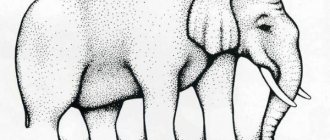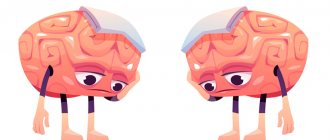Sensation disorders – psychosensory disorders
Psychosensory disorder, in particular metamorphopsia, is a disorder of sensation, which is expressed in a distorted perception of the shapes, sizes and spatial arrangement of actually existing surrounding objects.
In the first case, we can say that Alice was dealing with macropsia (the objects around her seemed to her larger than the size they actually are). After eating the pie, it was time for micropsia (they became much smaller than their actual size).
In addition, with such a disorder of sensation, surrounding objects may also change in shape (become curved, diamond-shaped, elongated or bulgy).
There is also dysmorphopsia - with curved shapes and polyopsia , when surrounding objects become larger, optical allesthesia , when it seems that surrounding things begin to move in space, approach the person, put pressure on him, or even press in. Thus, in human perception, the walls can either narrow or move apart, and the floor can move in a wave-like manner.
With psychosensory disorders, not only an altered perception of objects around a person is possible, but also a violation of the “scheme of one’s own body” - depersonalization . That is, the perception of the body as a whole or its individual parts does not correspond to reality.
For example, it may seem to a person that he has absolutely no back or spine, and his head immediately goes into his legs, or that it has reached enormous proportions and fills all the space in the room.
A person may also perceive the location of individual parts of his body distorted (for example, the head ceases to be part of the body or one leg is divided into two).
Sometimes this perception of a "body schema" can disappear when a person consciously focuses his vision and attention on the distorted part of the body. But, as soon as you close your eyes, the erroneous perception returns.
It is important to note that with psychosensory disorders a person perceives real objects and their real appearance.
If the real object is present, but is perceived inadequately (perverted in essence), in a completely different, erroneously distorted form, we are talking about illusions.
Psychological defense - rationalization
People who have experienced discomfort from failure, the collapse of a dream, begin to look for reasons that would justify them. The subconscious helpfully offers options: an overly picky teacher, a tyrant boss, an eccentric wife - all these thoughts switch attention to another object. In his own eyes, a person feels right and does not see his mistakes. This model of behavior also includes parents who raise their hands against their child. Aggression, dissatisfaction with life, and other causes of stress are reflected in the baby, while adults reassure themselves that this is for good purposes. This psychological defense provides only temporary relief, smoothes out anxiety, and dulls conscience. Most importantly, it does not create a constructive model of behavior and does not contribute to solving internal problems.
Illusions – distorted perception of objects and phenomena (objects)
Illusions, unlike hallucinations, can also occur in a completely healthy person.
Physical illusions
The reason for their occurrence is, for example, the laws of physics (the well-known broken spoon in a glass of water, which arises due to different light transmittance of the media).
Physiologically illusions
Occur under special conditions of the analyzer (for example, when driving in transport, there is a feeling that the car continues to move even when the driver presses the brake or a frozen picture of nature outside the window of a moving train);
Psychic illusions
They arise when a person perceives objects or objects inadequately due to his special mental state (affect). When a feeling of fear, anxiety is expressed, and, being in tension, we expect something dangerous for us, an ordinary branch outside the window in the dark may seem like a monster to us, and affectogenic illusions . When, against the background of strong emotions, threats, accusations, and misunderstandings of the meaning of the words of others are heard in ordinary conversation, verbal illusions can arise. With mild non-productive disturbances of consciousness as a result of intoxication, elevated temperature, surrounding objects can take on a fantastic appearance (pareidolic illusions ).
Sometimes illusions can arise in conditions of difficult perception, for example, twilight disorders of consciousness.
crowding out
This method of defense is associated with partial amnesia. The traumatic situation is repressed into the subconscious; a person can only remember it under hypnosis. In particular, Freud, studying the numerous neuroses of patients, put forward the theory that psychogenic factors, in which he saw the causes of stress, go deeper into the subconscious area. When the unconscious becomes conscious, the neurotic syndrome disappears. Repression, as a psychological attitude, is widely played out in films. More common is partial movement of information into the subconscious area. For example, a person completely forgets situations where he behaved unworthily and showed himself dishonestly. At first glance, this saves you from remorse. But hidden guilt can cause psychosomatic diseases - migraine, gastritis, hypertension. The best option is to be aware of the situation, even if the person in it looks unsightly. Reframing will help you draw conclusions and change behavior.
Hallucinations are a disorder that manifests itself in the perception of objects that do not really exist.
Hallucinations can have a clear localization in space and look natural, very similar to real objects, without raising the slightest doubt about their reality ( true hallucinations ), when patients believe that they are seen or heard by everyone around them. True hallucinations can occur with organic diseases of the brain (intoxication and infectious origin, traumatic brain injury), as well as with pathologies such as internal bleeding, influenza, typhus and others.
Hallucinations may not have a clear localization in space, but occur in the human body (in the chest, stomach, more often in the head) ( pseudohallucinations ), when patients report that they hear them or see them only. In this case, we are dealing with hallucinations that occur only with a mental disorder such as schizophrenia .
In addition to this division, hallucinations are classified according to the senses:
- auditory (call, call, beep, verbal - words, phrases, sentences. If a person hears comments or a discussion of ongoing events - commentary hallucinations; if they are ordered to do something - imperative;
- visual (individual elements ( photopsia ), non-existent animals, insects, people, individual scenes, one’s own double);
- olfactory (unpleasant odors (for example, spoiled meat, poison, smoke);
- tactile (sensation of cold or burning touches ( thermal ), sharply grasping ( haptic ) sensation of liquid or sticky on the body, spread of parasites, insects throughout the body;
- visceral ( the presence of something foreign inside the body).
Hallucinations are of a combined type, when, for example, a person simultaneously sees a sea monster that smells unpleasant and slides over his body.
In any case, hallucinations are a disorder of perception in the absence of a real object, arising on a painful basis and not being criticized by patients.
Therefore, if your loved ones tell you that they see non-existent objects or people or hear non-existent sounds, smells, voices, you should know that this is a manifestation of mental illness, and not some kind of stupidity or misunderstanding, which you can simply brush aside and ignore. If treatment is started in time, the patient can achieve significant improvement or even recovery. Help yourself or your loved ones!
We constantly detect plagiarism on our materials without providing a clickable follow link to them. In this case, without warning, we turn to Google DMCA , which leads to pessimization of the plagiarist. On the contrary, we welcome the popularization of our materials, but with the obligatory active follow link to this page psyhosoma.com/gallyucinacii-illyuzii-psixosensornye-rasstrojstva/ .
Distorted perception of reality
In the process of working with clients, it is easy to notice that the way he perceives what is happening is important for a person’s state of mind.
Perception is the beginning and the end of how a person feels, what actions he performs, what character traits he acquires, how he lives, what fate he reaps.
When working with any request, I am forced and invariably come to the beginning, the source from which it all began. This is how a person perceived the situation.
When a client talks a lot and in detail about his difficulties, failures, injustice, illness, humiliation, fear, rejection, etc., then I understand that the essence of his experiences lies in the assessment of the event as negative, the consequences of which cannot be overcome. This is the first thing you can work with; the rest of what the client is worried about can fall apart during the work on its own.
We are taught to evaluate, i.e. interpret events from early childhood. The baby is already told: “This is not good. This can’t be done, it will be va-va.” The student is given grades, pointing out mistakes, without focusing on what is good. This is how we learn negative thinking.
The first thing we do when faced with life events is to instinctively evaluate what is happening: dangerous - not dangerous, right - wrong, good - bad. This is how we learn black and white thinking.
Clients, when describing their problem, talk about events in terms of assessment and interpretation. It is very difficult to obtain a statement of simple facts in order to form an independent view. The client immediately offers his own interpretation of events from the point of view of his experience and upbringing. There is no impartial presentation of facts and analysis as such. And there is immediately an assessment, an interpretation, which is accepted as the truth. Of course, this is true for this person. But if we take into account that each person has his own unique experience and upbringing, then we have to admit that everyone has their own view, everyone looks at the same event through their own filter, which takes into account some facts, discards others as unimportant or does not notice them as if they did not exist.
Consciousness works selectively and associatively. This is a feature of the psyche. This protects the psyche from overload. Consciousness, as it were, scans events and highlights what is consistent with existing beliefs. This perception is unconscious and typical for any person.
Thus, all distortions begin with perception, and this subsequently leads to destruction.
Is it right to say that if you change your perception style, you can avoid undesirable consequences in the form of illnesses, failures, and nervous disorders?
Is realistic perception possible in principle?
In any case, you can set the task: to bring the existing perception closer to reality, and then the client himself will witness how his life difficulties crumble one after another.
The difficulty lies in the fact that the client lives in captivity of his images and ideals and does not connect his problems with errors of perception. He clings tenaciously to his beliefs, which were created under certain circumstances and are not valid in other contexts. These beliefs are the support in life, the guidelines that guide the path of life.
It is difficult for a person to tolerate uncertainty. The unknown scares him. He is afraid to trust not in ideas, but in life itself, which is unfolding right now in its incomprehensible reality right in front of him. And he directs his attention to his head, to reasoning, to comparisons with ideals, to assessments and criticism. Fear of the unknowable forces one to define, explain, give interpretations to everything that happens: this is why, he thinks this, they want this,... - explanations, justifications, thinking for others.
It's scary to throw away ideas, and face the truth, and accept life as it is, without explanations or excuses.
It’s scary to give up black and white thinking, to say to yourself: it happens like this, but it happens differently, it’s different for everyone, a lot depends on the context.
A pattern of perception has been created, and it takes courage to overcome it.
When a person gets stuck in the emotional assessment of what is happening, he does not act. Again and again he experiences the event as not fair, not right.
We need to wake up from the hypnosis of created ideal images and ask ourselves: if this is so, how can I act for the benefit of myself and others? Is it possible to improve anything? How can we make something good out of this?
There are no distortions of perception when a person perceives only what is, without adding or subtracting anything. We often do not realize how much we are in isolation from reality, we endow objects with non-existent qualities, we assume and guess without having real facts for this. The more thoughts are divorced from reality, the more incomprehensible and destructive the individual’s behavior seems to others.
It seems that it’s easier to see only what is, without allowing the mind to play out in its fantasies? In reality this turns out to be difficult. A restless mind reproduces new thoughts without stopping, regardless of the person’s will. Sometimes the mind completely drags a person into its sweet fantasies of happiness or suffering. It is surprising that experiences from fantasies are just as real as those from real events. That is, in fantasies, events are not real, but experiences are real. This trap is addictive with its simplicity and accessibility. You can simply, effortlessly, have a wide variety of experiences without, as it seems, putting yourself at risk. It is difficult to escape from such an infantile emotional experience. The side effect is that real life is bursting at the seams. A person becomes non-adaptive and becomes more and more inappropriate in behavior, breaking away from reality.
Mental activity is natural and necessary for humans. It is useful for scientific and creative activities that have specific goals and achievements. Creative mental energy can be directed to analyzing facts, planning events in your life, and finding ways to achieve your goals. But a person with a distorted perception gets stuck in assessments and emotions and is inactive. He conducts endless monologues, reasoning and proving, resisting what is.
It seems to me that one of the most important tasks of any person is to develop the ability to perceive reality realistically. This kind of work can be done independently with the help of concentration training. Methods available to everyone: prayers, meditation, concentration exercises.
The ability to see clearly and clearly, without clouding, brings a calm attitude to current events into life and allows you to more effectively solve life’s problems. Accepting everything that is allows you to agree with life as a whole, with the fact that life is larger than an individual person, and it is naive for a small part to fight against the whole. Reverence for the fact that more of us gives us the opportunity to measure our strength and not waste it on something that is impossible not to fight at windmills.
An impartial perception of what exists expands the horizons of vision, allowing you to step out of the framework of narrow thinking, encounter something new and gain new experience. Broad vision allows you to see options for solving problems that were previously hidden from view.
Children's fantasies and perceptual disorders
Child psychiatry and psychology is a special type of medicine. Children are great dreamers and inventors, and the increased reactivity of the child’s psyche and insignificant life experience do not give the child the opportunity to independently correct unreal sensations in time. That is why perception disorders in children are a special area of pedagogy, psychology and psychiatry. Visual and auditory illusions are one of the components of every person’s childhood. A scary fairy tale told at night becomes a real nightmare for the baby, hiding under the crib or in the closet. Most often, such disorders occur in the evening, affecting the child’s fatigue and drowsiness. Scary tales and stories, especially those told to a baby at night, can become the basis for the development of a neurotic state. Hallucinations occur in children most often against the background of somatic and infectious diseases as a result of increased body temperature. The age at which such disorders most often manifest is 5-7 years. Hallucinations of this nature are elementary - sparks, flashes of light, outlines or images of people, animals, and from the sounds children hear shouts, knocking, voices of birds or animals. All these visions are perceived by the child as a fairy tale.
Children of different ages can also suffer from manifestations of schizophrenia. In this case, all hallucinations acquire a complex, often ominous character. The plot of hallucinations is complex, often endangering the health or even the life of the baby. Children of older adolescence, which is 12-14 years old, are characterized by the development of taste and tactile hallucinations, the child begins to refuse previously loved foods, and his character and behavior change.
Pediatrics and child psychiatry classifies children with congenital disturbances of perception into a special group. In these cases, the child grows and learns to compensate for the lack of some sensations by enhancing the development of other sensory abilities. A classic example is that a child with congenital hearing loss has excellent vision, notices the smallest details, and pays more attention to minor details of the surrounding reality.
Perception is the basis of knowledge of the surrounding world in all its manifestations. In order to feel, a person is given six sense organs and nine types of receptors. But in addition to sensations, the information received must be transmitted to the appropriate parts of the brain, where it must undergo a process of processing and analysis, drawing up an overall picture of reality based on a complex of sensations and life experiences. The result of perception is a picture of the surrounding reality. Violations in at least one link in the chain of obtaining a picture of the world lead to a distortion of reality. Psychiatry as a field of clinical medicine studies the causes of appearance, stages of development, signs and symptoms, methods of treatment and prevention of perception disorders, both individual phenomena and components of general human health problems.
Projection
One type of psychological defense is projection, when an individual attributes unseemly motives and actions to other people. For example, an envious person accuses others of envy, a stupid person thinks everyone is stupid, and an aggressive person sees aggression in others. A person’s desire to believe that others have shortcomings inherent in himself is what projection consists of. Irritability, outbursts of anger, suspiciousness - various causes of stress - are transferred to another. The person himself forgets that these are his problems and distances himself from them. The best method of getting rid of psychological projection is healthy self-criticism.
Metamorphosis of worldview
The first step towards a reboot is changing your worldview. Looking at things more broadly, being a more attentive communicator, solving problems more effectively - all this is easier said than done. But there are habits that can help.
Five minute time out
Got excited, blurted out without thinking - most of us regret when in disputes we use the wrong arguments or do it too emotionally. One of the founders of the famous company 37signals, as well as co-author of the popular Signal vs Noise blog, Jason Fried, came up with a simple solution to this problem - a five-minute timeout.
Once at a conference, I argued until I was hoarse with my opponent. Until he suddenly said: “Boy, take a time out!” I asked what he meant? He replied that it is normal to have different points of view and defend them. But some ideas take time to understand and accept.
Think for five minutes and then tell me if you want to argue any more. He was right. In that discussion, I just wanted to prove something, not learn something.
Sometimes you don't even have five minutes - you need an instant reaction. But when communicating by e-mail, on social networks, or even answering questions at a conference, you can pause for quite a long time, weigh and think about your answer. Allow your brain to “digest” the incoming information - this will definitely affect your own views.
Kaleidoscope of judgments
David Foster Wallace, one of the most prominent American prose writers of our time, has repeatedly noted the dangers of a self-centered worldview and “default” thinking. In his opinion, it is extremely important to try on someone else’s point of view.
Imagine that you are standing in line at a supermarket. In front of you is a woman with a small child. He is naughty, she slaps him on the butt. Don’t rush to judge her, think about what you would do in her place?
Another example. You were cut off on the road. The first reaction is negative, but if you imagine yourself in the role of an impolite driver and think about what reasons you might have for this, your judgment about the situation may change. Wallace recommends doing these tricks regularly to help you better understand the world around you.
View from the outside
Another effective technique described by Wallace is to look at your work, creativity, or just your day from the outside.
Scientists have come up with a method to relieve irritation. To do this, you need to describe the annoying situation (orally or in writing) from a third person. It is assumed that this approach allows you to approach the assessment of the situation objectively, abstracting from the negative emotions associated with this experience. This kind of distancing can change not only one's perspective on a situation, but the situation itself.
My vision is just my vision. It's not the only one. Taking a look at a given situation “from the outside” is a good exercise for self-development.
This technique often reveals hidden problems that you could not see due to the umwelt.
History of discovery
The perception of reality began to receive attention in 1899. Illusions were familiar to people before, but were perceived as something mystical and frightening.
The first researchers in this direction conducted experiments to prove that illusions are based on people's expectations. These experiments involved lifting weights while blind. The buckets contained the same amount of sand, but people were told that they would now be allowed to lift the bucket even heavier. Participants in the experiment believed that buckets of equal weight were heavier than each other.
The first scientist to conduct such experiments was R. Muller. He asked people to estimate the same weight in containers of different sizes.
After conducting the experiments, Müller presented his personal arguments regarding similar distortions in the Würzburg school. Scientists from other European psychological schools began to develop and study this concept in the first half of the 20th century. They called illusions the anomalous phenomena that occur in nature - mirages, visual distortions due to the refraction of light. Psychologists from the Gestalt school shared this opinion.
Far and near
Disorders of sensations and perception of received data are closely interrelated. Receptors that receive information about the surrounding reality transmit nerve impulses to the brain, where analysis and processing of the received information occurs and a response occurs in the form of an idea of an object or phenomenon that affects the receptors. Moreover, some of the receptors should receive such an effect through direct contact with the object, and some through space. So, for example, taste sensations arise when food enters the mouth and tongue. But vision allows you to see objects at a distance. The perception of received information through various senses and receptors is the main mechanism for human cognition of the world. Perceptual disorders are a complex physiological and psychological problem.
Knowing yourself
Psychological methods of defense during a traumatic situation can smooth out emotional discomfort. But prolonged stay within the transformed reality reduces adaptation to the surrounding world and, rather, can cause neurosis and depression. The various causes of stress that lead to internal conflicts must be felt and brought to a conscious level. The ability to know yourself will give you the opportunity to become a mature person and find spiritual harmony. Possessing clear thinking, the ability to look at oneself from the outside, optimism and a thirst for life, a person acquires a high level of psychological security.










